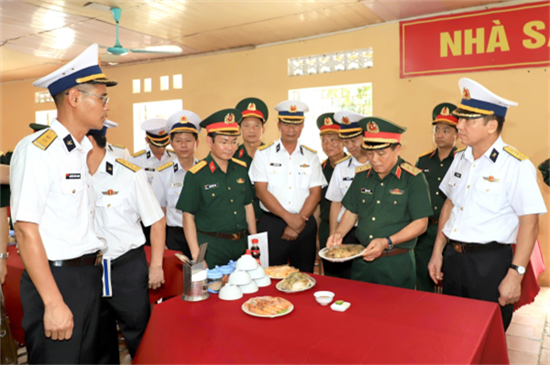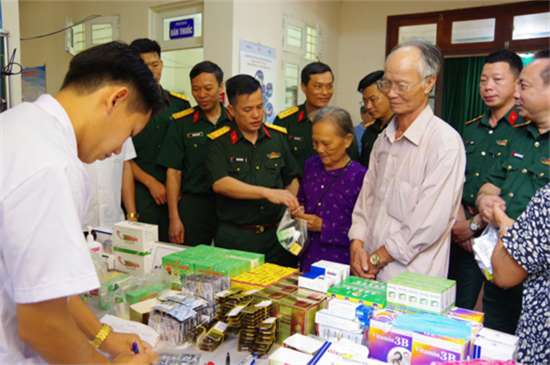Continuing to advance the Emulation movement of “Military Logistics Sector following Uncle Ho’s teachings”
In recent years, under the leadership and direction of the Central Military Commission and the Ministry of National Defence, the Emulation movement of “Military Logistics sector following Uncle Ho’s teachings” has achieved significant results. This provides a strong foundation for the entire Military to continue promoting the Movement, raising it to new heights and creating momentum to successfully fulfil logistical tasks - thereby meeting the demands of building the Army, consolidating national defence and safeguarding the Fatherland.
Recognising the importance and profound meaning of the Emulation movement “Military Logistics sector following Uncle Ho’s teachings” (hereafter referred to as the Movement) for fulfilling both logistical and political missions, Party committees and commanders across all agencies and units have consistently given it close attention. The Movement has been implemented in a rigorous and orderly fashion, marked by creative and effective methods. Propaganda and educational activities have been carried out extensively, fostering unity of awareness, sense of responsibility and enthusiasm among cadres and soldiers, and encouraging the voluntary and wholehearted participation of collectives and individuals alike.
To improve the Movement effectiveness, agencies and units have translated the objectives of “One focus, three breakthroughs” and “Five Goods” into practical emulation targets aligned with their specific functions, tasks and local conditions. The Movement has been implemented comprehensively, while still focusing on key priorities, with the aim of improving all aspects of logistics work, overcoming weaknesses and shortcomings, and ensuring the successful implementation of Resolution No.1658-NQ/QUTW (dated 20 December 2022) of the Central Military Commission on the Military logistics work through 2030 and beyond.
 |
| Lt. Gen. Tran Minh Duc checks catering work for A80 task |
Faithfully following Uncle Ho’s teachings, the entire Military - spearheaded by the Logistics Sector - have overcome difficulties and successfully fulfilled logistical missions, ensuring timely and adequate supplies for training, combat readiness and unexpected tasks. Logistics support has seen steady and solid development, with significant improvements in soldiers’ living conditions. The movement to expand production and self-sufficiency has developed strongly at all three levels. The Military now meets the majority of its own food needs, with many units entirely self-sufficient in fresh vegetables, meat and fish, thereby ensuring reliable food supplies and improving meal quality. Uniform provision has also made major progress, with research, design and improvements enhancing the quality of military apparel. Notable examples include the K20 field uniform and the K24 ceremonial dress, both of which contribute positively to building a more formal and standardised Military image. In military medicine, the Movement has led to comprehensive advances in healthcare, improving health management, treatment and protection for troops, with unit health rates consistently above 98.5%. At the same time, the Movement has spurred improvements in barracks, fuel, and transport services, raising efficiency in the management and use of logistics materials, finance and public assets, and preventing loss, corruption or waste. Importantly, the Movement has also supported the streamlining and strengthening of logistics and technical agencies at all levels, ensuring they are leaner and more effective. It has accelerated administrative reform and digital transformation, while reinforcing order, discipline and modern practices in logistics work - ensuring it continues to meet the demands of new tasks in the current situation.
In the years ahead, the tasks of national defence, military development, Military building and Fatherland defence will enter a new stage. The armed forces will focus on studying and implementing the resolutions of Party congresses at all levels for the 2025-2030 term, as well as the 14th National Party Congress, and on carrying out many critical missions and tasks. This will place ever-higher demands on logistics and technical support, particularly in ensuring training, combat readiness and unexpected missions. In this context, alongside the comprehensive implementation of all aspects of work, the entire Military - spearheaded by the Logistics and Technical branches - must continue to provide advice, direction and leadership in advancing the emulation movement “Military Logistics sector following Uncle Ho’s teachings”. The aim is to make the Movement deeper and more substantive, creating fresh impetus to inspire officers and soldiers to unite, overcome every difficulty and challenge, and excel in logistics work. To this end, several core tasks require focused attention.
First and foremost, propaganda and education must be stepped up to enhance awareness, strengthen responsibility, and foster the right motivation and determination to emulate among cadres and soldiers. This is the fundamental and most important solution to ensure that the Movement is pursued with coherence, continuity and sustainability, unifying thought, awareness and action across all forces.
Party committees and commanders at every level must therefore attach great importance to educating officers and soldiers about the objectives, significance and requirements of the Movement. They must mobilise and unleash the potential and creativity of all forces - particularly those of the Logistics and Technical sectors - so as to build combined strength and fulfil assigned missions with excellence. Educational content must focus on thoroughly disseminating Party resolutions, directives and guidance on logistics, as well as on clarifying the Movement’s aims, objectives and targets. In doing so, it will contribute to fulfilling political tasks, building “comprehensively strong and exemplary” units, and improving the wellbeing of cadres and soldiers. Equally, it is essential to innovate methods and forms of propaganda and education, ensuring they are diverse, lively, practical and effective, with a strong orientation towards the grassroots level. Results achieved by agencies and units should be regularly publicised, while best practices, creative approaches and exemplary role models should be shared widely. This will deepen officers’ and soldiers’ understanding, instil the right motivation to emulate, and nurture a sense of responsibility, voluntarism, dynamism and creativity in implementation. At the same time, efforts must be made to detect and promptly correct any distorted perceptions - such as the belief that this Movement belongs solely to the Logistics and Technical Sector - or any tendencies towards formality, complacency or stagnation.
 |
| Division 346 of Military Region 1 provides free medicine for policy beneficiaries |
Second, it is vital to strengthen the leadership, direction and oversight of Party committees and commanders at all levels in implementing the Movement. Experience has shown that wherever and whenever Party committees and commanders devote close attention and guidance, the Movement flourishes and yields strong results - and conversely, where such leadership is absent, outcomes are weaker. Accordingly, Party committees and commanders across all agencies and units must intensify their leadership and direction in carrying out the content and targets of the Movement. These should be incorporated into the regular resolutions of Party committees at each level, treated as a central task, and directly linked to the duties and responsibilities of the cadre corps. This approach elevates the responsibility of key leaders in directing, organising, supervising and sustaining the Movement so that it develops continuously and widely. To meet the demands of the new situation, agencies and units must promptly review, adjust and supplement their emulation targets and measures for the 2025-2030 period, closely aligning them with the implementation of Resolution No.1658-NQ/QUTW of the Central Military Commission. Such adjustments must be consistent with each unit’s functions and tasks, while ensuring feasibility and effectiveness. At the same time, it is necessary to strengthen the Steering Committees for the Movement and the campaign “Good, durable, safe, economical management and use of weapons, technical equipment, and traffic safety” at all levels, ensuring unified organisation from the Ministry of National Defence down to the grassroots. This will guarantee close, effective implementation tailored to real-world conditions. Logistics and technical agencies at every level must further enhance their role as standing bodies: providing sound advice, direction, planning and organisation for the Movement. Particular attention should be paid to aligning activities with military and defence tasks and with logistical and technical directives; accurately identifying key priorities and breakthrough areas; and actively conducting inspection, supervision, monitoring and assistance. This will help units overcome difficulties, address weaknesses decisively, and ensure timely proposals on leadership and guidance to raise the quality and effectiveness of the Movement.
Third, attention must be paid to selecting the right content and renewing the forms and methods of implementing the Movement in line with the characteristics and missions of each agency and unit. In doing so, units must adhere closely to the Movement’s objectives and the themes of “One Focus, Three Breakthroughs” and “Five Goods”. They should clearly define emulation content linked to their core political tasks, addressing weaknesses, shortcomings and difficult issues. Emulation must be tied to the daily work of every cadre, Party member and soldier, with specific, measurable targets set for each stage and mission, avoiding generalisation or formality. Careful preparation of personnel means and conditions must be ensured so that each task and target is carried out decisively to completion. The methods of implementing the Movement should be diverse and engaging, inspiring patriotism, voluntarism and creativity among officers and soldiers. Regular emulation should be closely combined with peak drives, breakthrough campaigns and emulation activities launched by higher levels and different branches. In the coming period, the Movement should focus on renewing and improving methods of providing logistical supplies, effectively implementing planned logistics projects and programmes, and raising the quality of scientific research while accelerating digital transformation. By 2030, the aim is to basically complete the development of a modern, secure and synchronised information technology infrastructure, capable of supporting a digital working environment and progressing towards automated command, direction, management and administration in logistics and technical work. Alongside this, resources must be harnessed to improve the quality of supply in all fields, stabilise and improve troops’ living standards and health, and build logistics and technical agencies at all levels into comprehensively strong, “exemplary and typical” units - thus making an important contribution to fulfilling military and defence tasks and building a revolutionary, regular, elite and modern Vietnam People’s Army.
Fourth, efforts must be stepped up to build and expand exemplary models and to strengthen the review and lessons-learned process in implementing the Movement. This is both a mission and a crucial solution that directly drives the Movement forward. Accordingly, in the coming period, agencies and units - particularly Steering Committees and Standing Bodies of the Movement at all levels - must remain deeply engaged, studying the experiences and achievements of collectives and individuals in order to identify, nurture, and expand advanced models.
This process must be led and directed closely, ensuring that all four stages - discovery, cultivation, review and replication of exemplary models - are carried out in a systematic and coordinated manner. To guarantee success and enhance the spread of effective models, emphasis should be placed on selecting and investing in pilot examples from units operating under difficult conditions, focused on key priorities of the Movement, new areas of work, and persistent shortcomings in logistics. Exemplary individuals and collectives should be tested in challenging, complex environments where new or difficult tasks must be addressed. At the same time, agencies and units must conduct thorough reviews, draw lessons, and give timely recognition and rewards to collectives and individuals with outstanding achievements and examples of “good people, good deeds”. Such recognition must be transparent, democratic, fair, accurate, and timely - honouring the right people for the right achievements, thereby spreading positive influence and helping the Movement to grow deeper, broader and stronger.
Proud of the results already achieved, the entire Military should continue to uphold responsibility and determination in striving to fulfil the objectives and content of the Emulation movement “Military Logistics sector following Uncle Ho’s teachings”. This will generate the momentum needed to complete logistical and technical tasks successfully, and to contribute to building a revolutionary, regular, elite and modern Army - resolutely defending the Socialist Republic of Vietnam.
Lieutenant General TRAN MINH DUC, Chief of the General Department of Logistics and Technology